|
I am "one of those" tens of thousands
of youngsters in Memphis that had his first round of golf (circa 1960) at the
Overton Park Golf Course in Midtown, the second oldest municipal golf course in
America, nestled in one of America's greatest urban parks. Our family became
members of Chickasaw Country Club shortly thereafter, and while there was an
upgrade in my surroundings, there was not an upgrade in my skills, nor in my
interests. I seemed to do better at miniature golf (Putt Putt on Perkins by the
railroad tracks or Al's Golfdom in Parkway Village) than anything else. But, I
was well-coordinated enough to enjoy golf (almost), but it always remained
secondary in the childhood sports pursuits behind driveway basketball, bicycle
riding (everywhere) and "flies and grounders" (anywhere). I enjoy playing golf.
I have never hit a hole-in-one, but my older brother has. I did score an eagle
on # 15 a Pine Hill by chipping in a shot from about 90 yards off the green. My
sister is very good at golf, better than me. Golf is good . . .
DTMC to FESJC Years
In the late 1960s while in high school, I had wandered over the original
Colonial Country Club in old East Memphis (Southern, Perkins, Park & Colonial)
to watch some PGA TOUR golf (The Memphis Invitational Open). I became a fan of
Lee Trevino at that time. In 1974, my friend Phil Cannon enlisted several of us
to work on the Press Room of the Danny Thomas Memphis Classic (DTMC) out at the
Colonial Country Club (in Cordova). Jack Bugbee, the Sports Information Director
at Memphis State University, was overseeing the effort and needed some runners
and worker bees in the room. I was selected to write the hole-by-hole scores on
a master scoreboard in the room, as I had fairly neat handwriting. Little did I
know what an opportunity that was going to afford me later on in life. Phil went
for the logistics like answering telephones and dumping ashtrays (yes, smoking
was still commonplace in the work site then). But Phil's inquisitive nature and
nose for production and/or real logistics; his initiative and always wanting to
be right in the middle of things (no matter how tough) eventually progressed him
into more and more responsibilities in the tournament. I believe Phil began his
volunteering at the tournament while still in high school. needed some runners
and worker bees in the room. I was selected to write the hole-by-hole scores on
a master scoreboard in the room, as I had fairly neat handwriting. Little did I
know what an opportunity that was going to afford me later on in life. Phil went
for the logistics like answering telephones and dumping ashtrays (yes, smoking
was still commonplace in the work site then). But Phil's inquisitive nature and
nose for production and/or real logistics; his initiative and always wanting to
be right in the middle of things (no matter how tough) eventually progressed him
into more and more responsibilities in the tournament. I believe Phil began his
volunteering at the tournament while still in high school.
Well, the PGA TOUR had a grizzled old veteran named Dominic Mirandi, who
traveled the country with the PGA TOUR each week, producing a very neatly
crafted, handwritten scoreboard for all players. Mirandi's scoreboard was "for
show", and was positioned on an outside wall of the clubhouse for the gallery of
fans. His distinct penmanship (which has to be an individualized form of
calligraphy) was about as "cool" as it gets. Of course, I thrived on it and
asked him questions about how to hold a marker and what is the maximum size a
certain width of marker should be used, before advancing or demoting to a more
appropriate size marker for the occasion, or even how to contrast different
colors. Oh yes, real technical stuff. One day in 1975 at the First Baptist
Church Activities Building, renovations were occurring to some of the rooms, and
I was allowed to use some scrap wood (from panels of the TV Room) to make a
specially-designed markers box, as I so admired the box that Dom Mirandi used.
Gene Bailey helped me cut the wood and I got some accessories (corners, handle,
latch, etc.) from Gate City Hardware on Summer Avenue. I am proud to say that
that over-designed and incredibly heavy markers box (16 X 20 X 12) of
half-inch-thick wood is a classic, with all sorts of stickers on it (like a
travel trunk). In 1983, it was placed in the watchcare of my brother, John Ogle,
who had also acquired the "golf scoring calligraphy" talent. In 1988, I began
using a smaller wooden box (used by paramedics to carry medical supplies) that
Jake Schorr had purchased at a City auction of Memphis Fire Department supplies.
Both wooden boxes are still in action today (2012)!
The style of "magic marker writing" (which really is not calligraphy) that I
developed was Upper Case Block Letters and a few fashionable numbers with exotic
titles such as the Sailboat 4, Snowman 8 or Arrowtop 3. I also received a couple
of tips from an unusual source, and that was Rev. Henry Love, Minister of
Education & Administration at the First Baptist Church (Poplar & Parkway), where
I was a part-time worker in the recreation program at the time. Mr. Love showed
me how to hold the chisel nib tip of the marker at a 45-degree angle and how to
use a ruler to more accurately "frame" the border of a poster. Of course, he
asked me to make posters for Sunday School programs and/or special church
announcements.
So, during the 1970s and early 1980s, I was able to work in the Press Room of
the DTMC for that magical week in the Summer each year, and in several other
local tournaments for and with local golf pro legends like Arnold Mears and Jake
Fondren. We had a blast - and saw a little history made, too. The 1977 DTMC was
one of the most remarkable years and set of circumstances in Memphis sports
scene history. The country was going through a recession and the DTMC did not
even have television coverage that year. There was even some doubt about the
future health and viability of the tournament, which now is the longest
continuously running professional sporting event in this City (1958-2012).
Back to 1977! Everything was being done manually, as this was before the
computer age. On Wednesday of the tournament week, I would get an alphabetized
list of all 150 participants, and it would take about six hours to write all of
the names (ten per sheet) on the specially designed score sheets (44" X 60").
The score sheets would then be taped to the long wall in the clubhouse Press
Room, with a Daily Summary Sheet prepared for quick reference in the center of
all of the score sheets that we stretched about sixty feet along the wall.
Actual players' scorecards were placed on a copier at each nine holes, and then
(young) runners would run the scorecards to three "official" scoring locations,
one being the Press Room, where Bob Winn would carefully check the arithmetic
and record the score. I would then manually write the hole-by-hole score as soon
as the scorecards arrived, and it was a continuous job all day long. Several
rows of banquet tables were set up (where both print and electronic media
representatives congregated - with manual typewriters) that stretched the length
of the room to view the updated action, all day long. On each Friday at the
close of the day when the final round of the second day of play had been
completed, a "cut" was made to the lowest seventy scores in the field. (John
still has the red "cut arrow" in the box and uses it to this day). So, we took
all of the score sheets down, and I re-wrote the names for the final two rounds
on new sheet (along with the 36-hole score), and we re-taped them back up on the
wall, along with the previous two days of Summary sheets. This would take well
after midnight to get completed.
Wednesday each week of the tournament was the Pro-Am Day, so scoring was only
for the teams and individual pros. But, on June 8, 1977, one of the celebrities,
former President Gerald Ford hit the "shot heard 'round the world". On the 5th
hole at Colonial Country Club in Cordova, he scored a Hole-In-One, which was a
very "presidential" thing to do. However, Gerald Ford was more known for hitting
spectators with errant shots than hitting the green in regulation! Being a
former President, Ford was provided Secret Service protection when out in
public. The only place to hold a press conference upon completion of the round
would be the Press Room (naturally) and right in my way of writing up all the
scores - ugh!. I survived. Prior to the press conference, all the Press Room
staff was cleared out of the room so that the room could be checked by the
Secret Service. It just so happened that I left my markers box locked, and
unfortunately with a wind-up alarm clock in it (tick, tock, tick, tock).
Needless to say, I was called back into the room to unlock the box to prove what
the tick-tocking was! No harm, no foul.
 On Friday, June 10, 1977, a veteran of the PGA TOUR, Al Geiberger, fired another
shot heard 'round the world, when, in the Second Round, he shot a 59 for the
first time in the history of PGA TOUR tournament play. After scoring a 72 (even par)
in the First Round on Thursday, he started on Hole # 10 and shot a 30 for his
first nine holes that day. He finished with a birdie on Hole # 9 to score a 29
on his second nine holes that day. His two-day total was 131 (13 strokes under
par) and catapulted him into a 6-stroke lead, after starting the day with a
7-stroke deficit (I bet that big of a swing has never occurred elsewhere in PGA
TOUR history). He "coasted" over the final two rounds with a 72 and 70 to win
the tournament without shooting a round in the 60s, the only time that has
occurred in the tournament's 54-year history!
On Friday, June 10, 1977, a veteran of the PGA TOUR, Al Geiberger, fired another
shot heard 'round the world, when, in the Second Round, he shot a 59 for the
first time in the history of PGA TOUR tournament play. After scoring a 72 (even par)
in the First Round on Thursday, he started on Hole # 10 and shot a 30 for his
first nine holes that day. He finished with a birdie on Hole # 9 to score a 29
on his second nine holes that day. His two-day total was 131 (13 strokes under
par) and catapulted him into a 6-stroke lead, after starting the day with a
7-stroke deficit (I bet that big of a swing has never occurred elsewhere in PGA
TOUR history). He "coasted" over the final two rounds with a 72 and 70 to win
the tournament without shooting a round in the 60s, the only time that has
occurred in the tournament's 54-year history!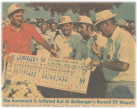 Well, once again another press
conference was held "in my way", but I did have time to cut two pieces of poster
board, tape them together end-to-end and then mock up an enlarged score card of
Al Geiberger's historic round. The reason why I did this was that the scoring
rows on the score sheets were only one inch tall, and when there are 140+ names
on the long wall, it is some times hard to focus on a particular score. The
enlarged scorecard allowed for the Well, once again another press
conference was held "in my way", but I did have time to cut two pieces of poster
board, tape them together end-to-end and then mock up an enlarged score card of
Al Geiberger's historic round. The reason why I did this was that the scoring
rows on the score sheets were only one inch tall, and when there are 140+ names
on the long wall, it is some times hard to focus on a particular score. The
enlarged scorecard allowed for the
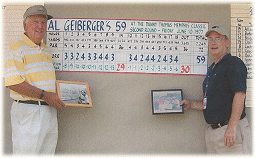 numbers to be three inches tall and two
inches wide with the number of the hole, yardage and par listed. And, I was
proud that the enlarged scorecard was used a the centerpiece backdrop to the
press conference that day. It would look swell in my house after the tournament,
too. Not so fast. numbers to be three inches tall and two
inches wide with the number of the hole, yardage and par listed. And, I was
proud that the enlarged scorecard was used a the centerpiece backdrop to the
press conference that day. It would look swell in my house after the tournament,
too. Not so fast.
It was decided that the DTMC needed to use the enlarged scorecard for photo
opportunities and the trophy presentation on the 18th green at the close of the
tournament on Sunday.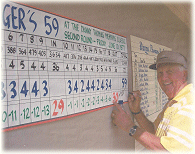 The classic photo of Al Geiberger, Vernon Bell, Danny
Thomas and Don Drinkard presenting both the champion's trophy along with the
enlarged scorecard is one of my favorites. There is even a copy hanging on the
wall at Mortimer's Restaurant in East Memphis. Well, the tournament brass
thought it was a good gesture to give Al Geiberger the enlarged scorecard, so it
never made my wall at home. However, Geiberger did carry the scorecard with him
to display when he talked about his historic round (hole-by-hole) to future
audiences. Al Geiberger also copyrighted the term "Mr. 59" The classic photo of Al Geiberger, Vernon Bell, Danny
Thomas and Don Drinkard presenting both the champion's trophy along with the
enlarged scorecard is one of my favorites. There is even a copy hanging on the
wall at Mortimer's Restaurant in East Memphis. Well, the tournament brass
thought it was a good gesture to give Al Geiberger the enlarged scorecard, so it
never made my wall at home. However, Geiberger did carry the scorecard with him
to display when he talked about his historic round (hole-by-hole) to future
audiences. Al Geiberger also copyrighted the term "Mr. 59" and his business card
was a double-truck that opened to display a replica of the actual scorecard that
he signed on June 10, 1977. Geiberger did return to Memphis in 2007 for the 30th
anniversary of the "First 59" and I did get to talk with him a few minutes, plus
have some photos made with him, with photos from 1977 - cool! and his business card
was a double-truck that opened to display a replica of the actual scorecard that
he signed on June 10, 1977. Geiberger did return to Memphis in 2007 for the 30th
anniversary of the "First 59" and I did get to talk with him a few minutes, plus
have some photos made with him, with photos from 1977 - cool!
Well, I continued to take the week off (vacation) from the Memphis Recreation
Department until 1983, when I was promoted to Administrative Manager (then
Deputy Director) of the Memphis Park Commission, and one week in the first week
of the Summer programs is not the right time to be gone from work. I had to
"give it up", but there was a better replacement in the wings as my younger
brother, John Ogle stepped in and continued the tradition to this day - except
for one year in the 1990s when he decided to take a honeymoon (for real, during
the golf tournament, no less!) and I had to (happily) step in to print the
numbers.
 Phil Cannon took a full-time job with the tournament in 1980s and
serves as the Tournament Director today. Bob Winn is the volunteer coordinator
for the Media Center, so it is always enjoyable to return to the tournament each
Summer to visit. In 2010, I coordinated a Charter Flight from Memphis to
Monterrey to convenience tour pros in getting from here to there (for the U.S.
Open) on a late Sunday afternoon with a direct flight. Well, that entailed 23
pros (along with a combination of wives, children, nannies, caddies and agents)
and 253 pieces of luggage, a Sheriff's escort to Wilson Air Center and a charter
flight - all while there a three-person playoff going on at the tournament site,
with one of the playoff participants booked on the charter. That was a long day.
In fact, now Phil has lets me compile and edit the Media Guide each Winter -
that's about a million numbers and letters to update, but it is a real challenge
and a good subject. www.stjudeclassic.com Phil Cannon took a full-time job with the tournament in 1980s and
serves as the Tournament Director today. Bob Winn is the volunteer coordinator
for the Media Center, so it is always enjoyable to return to the tournament each
Summer to visit. In 2010, I coordinated a Charter Flight from Memphis to
Monterrey to convenience tour pros in getting from here to there (for the U.S.
Open) on a late Sunday afternoon with a direct flight. Well, that entailed 23
pros (along with a combination of wives, children, nannies, caddies and agents)
and 253 pieces of luggage, a Sheriff's escort to Wilson Air Center and a charter
flight - all while there a three-person playoff going on at the tournament site,
with one of the playoff participants booked on the charter. That was a long day.
In fact, now Phil has lets me compile and edit the Media Guide each Winter -
that's about a million numbers and letters to update, but it is a real challenge
and a good subject. www.stjudeclassic.com
American Junior Golf Association Days
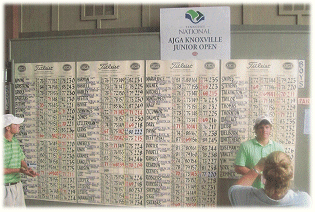 Back in 2007, the American Junior Golf Association (AJGA) came to TPC Southwind
and I was asked if I could keep a public scoreboard for three afternoons in
August. "Why sure", I said, not realizing that outside in August in the direct
angle of the sun, that the concrete would be 119 degrees and the wooden board
would rate 120 degrees. It was a hot one, but I did a good enough job that I was
asked if I was interested in being a Scoreboard Graphic Artist for AJGA events
around the country between May and August. I said sure again. So, off I went to
exotic places like Rome (Georgia), Columbus (Ohio), Mobile (Alabama),
Springfield (Missouri), Hilton Head (South Carolina), Tampa (Florida), Bristol
(Virginia), Avon (Ohio), Lenoir City (Tennessee), Franklin (Tennessee), but even
more fun places like Danbury (Connecticut) and Wenatchee (Washington) - yep, 150
miles east of Seattle in those arid Cascade Mountains
Back in 2007, the American Junior Golf Association (AJGA) came to TPC Southwind
and I was asked if I could keep a public scoreboard for three afternoons in
August. "Why sure", I said, not realizing that outside in August in the direct
angle of the sun, that the concrete would be 119 degrees and the wooden board
would rate 120 degrees. It was a hot one, but I did a good enough job that I was
asked if I was interested in being a Scoreboard Graphic Artist for AJGA events
around the country between May and August. I said sure again. So, off I went to
exotic places like Rome (Georgia), Columbus (Ohio), Mobile (Alabama),
Springfield (Missouri), Hilton Head (South Carolina), Tampa (Florida), Bristol
(Virginia), Avon (Ohio), Lenoir City (Tennessee), Franklin (Tennessee), but even
more fun places like Danbury (Connecticut) and Wenatchee (Washington) - yep, 150
miles east of Seattle in those arid Cascade Mountains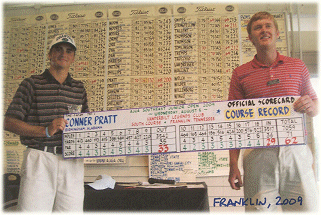 along the Columbia River.
The AJGA promotes first class golf tournaments for boys and girls, ages 12-18 in
various regional settings around the nation each Summer.
www.ajga.org. along the Columbia River.
The AJGA promotes first class golf tournaments for boys and girls, ages 12-18 in
various regional settings around the nation each Summer.
www.ajga.org.
Now, the golf scoring gig is three days; you work only in the afternoon at the
golf course; you have the AJGA taking care of travel, lodging, meals; and you
are a tourist the other half of the day. Boy, was I a "kid loose in the candy
store".
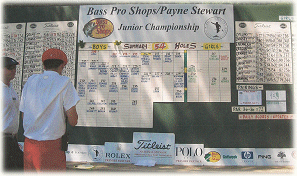 These cities and towns were pure "Americana", chock full of local
history, museums, and even old cemeteries like the Myrtle Hill Cemetery in Rome,
Georgia that has the "Tomb Of The Known Soldier" or the Aplets & Cotlets Factory
Tour in Cashmere, Washington or the Championship Putting Course in Leavenworth,
Washington. It was the tournament in Franklin, Tennessee that led me to the home
(Travelers Rest) of one of Memphis' co-founders, John Overton - which made me
curious about the other two Memphis co-founder's homes in the middle Tennessee
area (Andrew Jackson & The Hermitage, James Winchester & Cragfont) - which led
me to develop a PowerPoint presentation entitled "Before Memphis" which covers
the Native Americans, European explorers, settlers, early forts and everything
leading up to the founding of Memphis (1819), which is where most people
consider the "starting point". Well, "Before Memphis" is quite a story. The AJGA
gigs were a blessing and I never said "no" to an opportunity to do one. In 2010,
the AJGA began using a stick-on letter/number system rather than individuals
calligraphists, so my work became extinct. These cities and towns were pure "Americana", chock full of local
history, museums, and even old cemeteries like the Myrtle Hill Cemetery in Rome,
Georgia that has the "Tomb Of The Known Soldier" or the Aplets & Cotlets Factory
Tour in Cashmere, Washington or the Championship Putting Course in Leavenworth,
Washington. It was the tournament in Franklin, Tennessee that led me to the home
(Travelers Rest) of one of Memphis' co-founders, John Overton - which made me
curious about the other two Memphis co-founder's homes in the middle Tennessee
area (Andrew Jackson & The Hermitage, James Winchester & Cragfont) - which led
me to develop a PowerPoint presentation entitled "Before Memphis" which covers
the Native Americans, European explorers, settlers, early forts and everything
leading up to the founding of Memphis (1819), which is where most people
consider the "starting point". Well, "Before Memphis" is quite a story. The AJGA
gigs were a blessing and I never said "no" to an opportunity to do one. In 2010,
the AJGA began using a stick-on letter/number system rather than individuals
calligraphists, so my work became extinct.
Overton Park Open
The OPO began in 1935 and is maybe the oldest continuously operated Junior Golf
tournaments in America, played on the second oldest municipal golf course in the
nation. Overton Park Golf Course is a short course - good for beginners and
elderly. Many of Memphian has driven his or her first golf shot at OPGC. Even
though it is only a nine hole course, it has as much or more charm and heritage
as any 18-holer around. The Abe Goodman Clubhouse was built in 1926 and course
traverses in and around the beauty of The Old Forest and Lick Creek.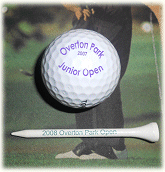
Although I never did play in the OPO, I always enjoyed the photographs that
appeared in the local newspapers showing young golfers in all sorts of poses and
positions, some juniors whose clubs were taller than they were! While helping
with the volunteer group Park Friends in 2007 with a clean-up of Rainbow Lake in
Overton Park, I was approached about sponsoring a hole in the tournament for
$100 to help defray the costs of that year's tournament. But, I thought of a
better contribution. When I was a kid golfer, I was always scrounging around the
outer limits of the course, or along a creek bed for golf balls. I felt that my
success was not only determined by the score that I shot, but also if I found
more balls in a day that I lost! So, golf balls and golf tees were a premium (or
luxury) item to an adolescent golfer. So, rather than chip in the $100 for a
sign with my name on it, in 2007 I purchased 300 golf balls and 1,000 golf tees
and had the words Overton Park Open and year imprinted on each. Each participant
received two golf balls and ten tees to do with whatever they wish - either play
the round with them, or keep them as a commemorative souvenir of the
participation. Needless to say, it cost me "a little bit more" than $100, but
the value was "priceless". So good, that I did it again in 2008.
Buddy McEwen & Public Golf, Singin' & Friendship
 Harry Stansifer McEwen (1940-2007). Buddy. From Nashville, Tennessee by way of
Memphis State University golf team to Davy Crockett Golf Course - "The Country
Club of Frayser" to The Settlers and Yodelin' Bud. I first "met" Buddy in the
1980s on the second floor of the Memphis Park Commission. He was an MPC golf pro
and had to conduct regular business up there. While an Assistant Pro at Ridgeway
Country Club in the 1960s (that Ridgeway CC was where the Hilton Hotel is now -
Poplar & I-240), he use to live in the King's Arms Apartments and would come
over the MUS to watch some high school basketball. Yep, and I was one of those
Owls that he remembered. Buddy was the Ultimate Memphis Sports Junkie. I bet
that he had a season ticket to every major and minor professional sports team
that played here for almost 40 years, from the Showboats in the USFL, to the
Rockers in the GBA. He was an M Club member from Memphis State University for
his golf team participation, and was a True Blue for both football and
basketball for over 35 years. (Buddy - as Harry McEwen - is in the FESJC Media
Guide page 114 this year for his 1971 round at old Colonial).
Harry Stansifer McEwen (1940-2007). Buddy. From Nashville, Tennessee by way of
Memphis State University golf team to Davy Crockett Golf Course - "The Country
Club of Frayser" to The Settlers and Yodelin' Bud. I first "met" Buddy in the
1980s on the second floor of the Memphis Park Commission. He was an MPC golf pro
and had to conduct regular business up there. While an Assistant Pro at Ridgeway
Country Club in the 1960s (that Ridgeway CC was where the Hilton Hotel is now -
Poplar & I-240), he use to live in the King's Arms Apartments and would come
over the MUS to watch some high school basketball. Yep, and I was one of those
Owls that he remembered. Buddy was the Ultimate Memphis Sports Junkie. I bet
that he had a season ticket to every major and minor professional sports team
that played here for almost 40 years, from the Showboats in the USFL, to the
Rockers in the GBA. He was an M Club member from Memphis State University for
his golf team participation, and was a True Blue for both football and
basketball for over 35 years. (Buddy - as Harry McEwen - is in the FESJC Media
Guide page 114 this year for his 1971 round at old Colonial).
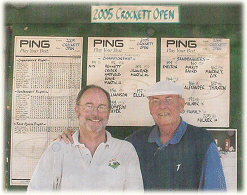 In the 1990s when I worked at the Memphis Queen Line (now Memphis Riverboats),
two crew members (Jason Nall and Rob Papps) liked to play golf. And they were
junior golfers in the 1980s that used to play in the Annual Crockett Junior
Open, operated by Buddy. So, our "home course" was split between Davy Crockett
Golf Course in Frayser and Meabowbrook Country Club in West Memphis. Our
friendship grew into a foursome that would play in some local charity
tournaments like the EastArk Open. Our fearsome group included Buddy, Stumpy,
Gimpy and Jimmy (as I just did not have a good nickname still don't, since
"Jimmy O" just does barely qualify). We golfed a lot, giggled a lot, shot some
good scores as a team every now and then. And Jimmy O sank an opening 15-foot
putt as the "D" player on the team, Buddy would instantly proclaim him "MVP" (as
I am sure that Buddy never wanted to stand over a 15-foot putt as an "A" player,
with points on the line!). In 1997 when my golf clubs were stolen from my car,
it was Buddy would had "the deal" for me for a new set. To this day, I still
carry my golf clubs in a bag embroidered "The Country Club of Frayser". And, who
could forget the "Crockett Open" golf tournament or the world famous,
super-delicious and loaded "Crockett Burger". Crockett maybe has the most
undulating and prettiest "lay of the land" of any golf course in the Memphis
area, and it one of those few courses that was an "out and back", meaning that
if you had a hook or slice, you could not play from the next fairway over. Davy
Crockett Golf Course was the first golf course in Memphis, and maybe the entire country, to have its own web site!
In the 1990s when I worked at the Memphis Queen Line (now Memphis Riverboats),
two crew members (Jason Nall and Rob Papps) liked to play golf. And they were
junior golfers in the 1980s that used to play in the Annual Crockett Junior
Open, operated by Buddy. So, our "home course" was split between Davy Crockett
Golf Course in Frayser and Meabowbrook Country Club in West Memphis. Our
friendship grew into a foursome that would play in some local charity
tournaments like the EastArk Open. Our fearsome group included Buddy, Stumpy,
Gimpy and Jimmy (as I just did not have a good nickname still don't, since
"Jimmy O" just does barely qualify). We golfed a lot, giggled a lot, shot some
good scores as a team every now and then. And Jimmy O sank an opening 15-foot
putt as the "D" player on the team, Buddy would instantly proclaim him "MVP" (as
I am sure that Buddy never wanted to stand over a 15-foot putt as an "A" player,
with points on the line!). In 1997 when my golf clubs were stolen from my car,
it was Buddy would had "the deal" for me for a new set. To this day, I still
carry my golf clubs in a bag embroidered "The Country Club of Frayser". And, who
could forget the "Crockett Open" golf tournament or the world famous,
super-delicious and loaded "Crockett Burger". Crockett maybe has the most
undulating and prettiest "lay of the land" of any golf course in the Memphis
area, and it one of those few courses that was an "out and back", meaning that
if you had a hook or slice, you could not play from the next fairway over. Davy
Crockett Golf Course was the first golf course in Memphis, and maybe the entire country, to have its own web site!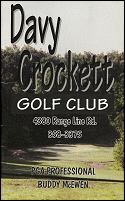
Buddy was also a regular on one-Friday-night-of-the-month at Kudzu's, 603 Monroe
Avenue (on The Edge of Downtown) near Sun Studio. In Buddy's previous life, he
had been a member of The Settlers, a long time popular Memphis bar band that
spanned over three decades. Yodelin' Bud would sing some old country classics
from George Jones to Merle Haggard to Webb Pierce, as he had strong feelings to
the Nashville sound, and Shelby Golf Course there. He would sing standards
including "Long Black
Veil", "Rocky Top", "I'm My Own Grandpa" and "Just a
Bowl of Butter Beans" and then end every night with his own version
of the classic "Tennessee Waltz". A hot (the window-unit ACs really could not
keep up) Summer Friday evening at Kudzu's was always a grand time . . .
Buddy was also a "history nut" and in the middle 2000s, he always tried to get
me to attend the monthly meeting of the West Tennessee Historical Society. Even
though I had museum experience with the Mississippi River Museum and the Memphis
Rock 'n' Soul Museum (MRNSM), I really did not have an interest in attending the
programs of WTHS. I attend today because of Buddy, and I think about him every
time that I go - and I am a WTHS Board Member now. Hmmm. On another note, Buddy
was a volunteer for me at MRNSM. On opening night gala (April 28, 2000), I
stationed Buddy in Gallery 2 to "guard" the Sputnik Monroe exhibit. Sputnik (a
pro wrestler who was never was known for singing) was featured in the era that
was being covered in Gallery 2 by the Smithsonian, as Sputnik was regarded as a
"civil rights pioneer". Sputnik was "230 pounds of twisted steel and sex appeal"
and Buddy got to meet one of his heroes that night - which made me quite a hero
to Buddy. The small things!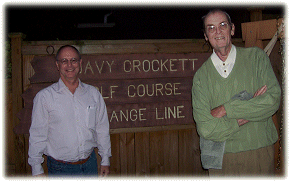
Well, Buddy got diagnosed with cancer, and by 2007, cancer was getting the
better (or worse) of the relationship. By that Summer Buddy was going to have to
move back to Nashville to be under the watch care of his brother, Tommy. I do
not think that it was a co-incidence that the "golf gods" scheduled an AJGA
tournament in July, 2007 the same week of the Overton Park Open. So, I was
unable to attend the OPO and distribute the above-mentioned golf balls and tees
to the junior players. Buddy did, and it was his "goodbye" to Memphis public
golf. And, you know, I bet he had a few "encouraging words" for each youngster
as he shook their hand that day. Golf is good.
That same Summer after Buddy had moved to Nashville, he was still holding his
single season ticket for Tiger Basketball. The University Athletic Department
was going through another one of those re-seating for donors at FedExForum.
Buddy was determined to drive from Nashville to as many Tiger home games as
possible. So, Buddy had me represent him for the re-seating, and he needed his
seat to be as close to the front door of FedExForum as possible, as it was a
struggle for him to walk to the other side. Well, that ended up being the year
that Derrick Rose was joining an Elite 8 team of Tigers, so demand and
expectation was high for Coach Cal's Tigers. In all of the re-shuffling of
seats, I was greeted with two options - up higher in the upper deck, or there
were a few seats in the end zones. I opted for the end zone, and there was a
single seat available on the third row. Imagine the acclamation that I got over
the phone from Buddy when I told him that he was just three rows from the . . .
. Pompon squad! Tiger basketball just took a back seat and "Jimmy Ogle, you da
man!" was the long distance shout-out from Nashville. Funny how I never thought
of it that way. Buddy never made a game that year, as he passed away on December
1.
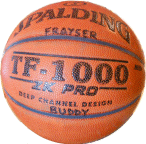 As a lasting tribute to Buddy, the "marks" that I put on the game ball (As
the official Scoreboard Operator, I took
the game ball home each night.) during the Tigers record
47-game home winning streak were "BUDDY" and "FRAYSER". With all that karma, no
wonder the Tigers played so well at home, until the February 4, 2008 game versus
The University of Tennessee (the # 1 vs. # 2, most-watched NCAA Basketball game
in ESPN history, by far). [Ask me some time about the very circuitous journey of
the Game Ball at the end of the game].
As a lasting tribute to Buddy, the "marks" that I put on the game ball (As
the official Scoreboard Operator, I took
the game ball home each night.) during the Tigers record
47-game home winning streak were "BUDDY" and "FRAYSER". With all that karma, no
wonder the Tigers played so well at home, until the February 4, 2008 game versus
The University of Tennessee (the # 1 vs. # 2, most-watched NCAA Basketball game
in ESPN history, by far). [Ask me some time about the very circuitous journey of
the Game Ball at the end of the game].
One more Buddy story. The original Davy Crockett sign that was a wooden,
trapezoidal-shaped sign from the 1960s,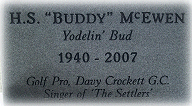 was soon to be replaced by a more modern
"Memphis Park Services" sign. So, with Buddy staying in Nashville and taking his
morning coffee from the high bluff overlooking the Cumberland River from Tommy's
backyard, what better way to surprise him that with sneaking the old sign (that
he had driven past on a daily basis for over 25+ years) up to Tommy's back yard.
The morning that Buddy arose to walk to the back yard, he told me that he
thought that "he was either in a dream or died and gone to golf heaven".
Although Buddy was cremated with wishes to have his ashes spread over several
golf courses, he did have a caveat in his will for a marker at Elmwood Cemetery
so that "the world new he had existed". On May 15, 2011, such a marker was
dedicated by some friends. Golf makes you do good things for others . . . was soon to be replaced by a more modern
"Memphis Park Services" sign. So, with Buddy staying in Nashville and taking his
morning coffee from the high bluff overlooking the Cumberland River from Tommy's
backyard, what better way to surprise him that with sneaking the old sign (that
he had driven past on a daily basis for over 25+ years) up to Tommy's back yard.
The morning that Buddy arose to walk to the back yard, he told me that he
thought that "he was either in a dream or died and gone to golf heaven".
Although Buddy was cremated with wishes to have his ashes spread over several
golf courses, he did have a caveat in his will for a marker at Elmwood Cemetery
so that "the world new he had existed". On May 15, 2011, such a marker was
dedicated by some friends. Golf makes you do good things for others . . .
Summary
Mark Twain says that "golf is a good walk spoiled", so he must not have liked
it, or had a bad snap hook, or never got to use a riding cart. But, golf is a
"lifetime sport" for all ages, both genders. It is a wonderful environment
(green grass, sand, trees, lakes, sunshine) and generally a "quiet" sport,
except when an occasional airplane flies overhead. One does not have to be great
to enjoy it - just hit one good shot out of 90 or 100 each day, and golf calls
you to return. In 2001, I had the opportunity to travel with Phil Cannon and
Bobby Hall to Augusta, Georgia for a Practice Round leading up to that year's
Masters tournament. All I am going to say is that is a "bucket list" experience,
whether or not you like golf - and I know some
other people who will agree with
me. Golf can be enjoyed in many ways, and not just by playing.
These are just a few of the stories and
photographs of "Golf" from Jimmy Ogle.
Next “Detour”
Coming Soon
|